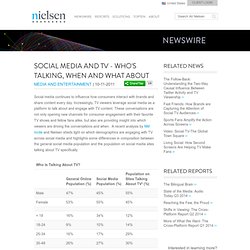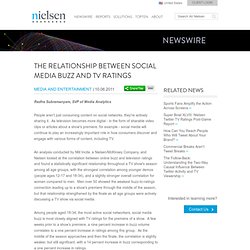

At Advertising Week 2011. At Advertising Week 2011. Social Media and TV – Who’s Talking, When and What About? Social media continues to influence how consumers interact with brands and share content every day.

Increasingly, TV viewers leverage social media as a platform to talk about and engage with TV content. These conversations are not only opening new channels for consumer engagement with their favorite TV shows and fellow fans alike, but also are providing insight into which viewers are driving the conversations and when. A recent analysis by NM Incite and Nielsen sheds light on which demographics are engaging with TV across social media and highlights some differences in composition between the general social media population and the population on social media sites talking about TV specifically. The social media population overall, skews slightly higher among females (55%), than males (45%). The Relationship Between Social Media Buzz and TV Ratings. Radha Subramanyam, SVP of Media Analytics People aren't just consuming content on social networks, they're actively sharing it.

As television becomes more digital - in the form of sharable video clips or articles about a show's premiere, for example - social media will continue to play an increasingly important role in how consumers discover and engage with various forms of content, including TV. An analysis conducted by NM Incite, a Nielsen/McKinsey Company, and Nielsen looked at the correlation between online buzz and television ratings and found a statistically significant relationship throughout a TV show's season among all age groups, with the strongest correlation among younger demos (people ages 12-17 and 18-34), and a slightly stronger overall correlation for women compared to men.